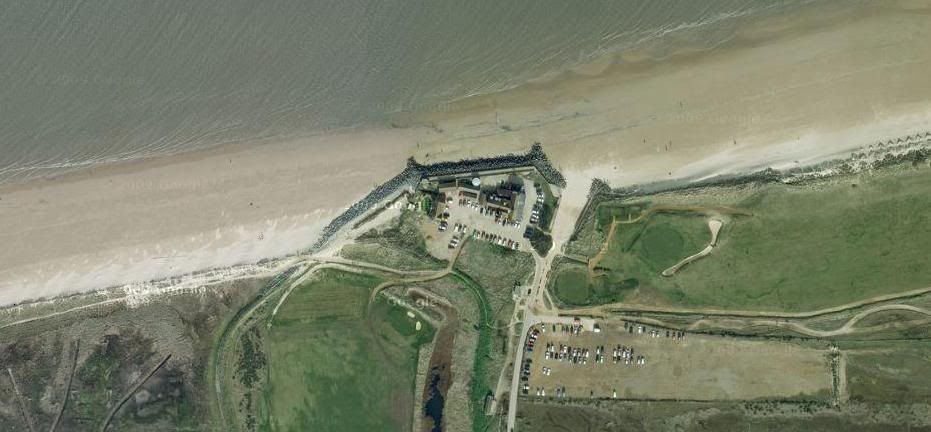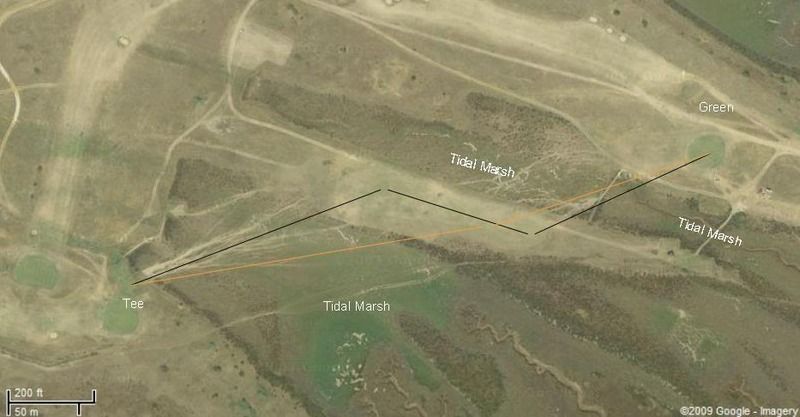I first played Royal West Norfolk, commonly known as Brancaster several years ago, after two things peaked my interest to play it as soon as possible: Firstly Tom Doakís write up in his
Confidential Guide made the place sound fascinating and secondly I discovered that the area is subject to heavy levels of erosion and being low lying also subject to the possibility of rising sea levels, so there is a good chance the course might be one of the first to disappear to these threatsÖ
The course has been around since 1892 and was laid out by Holcombe Ingleby, a local solicitor and politician. The course claims that the course has changed lttle since his day, but there have been some changes to the routing as we will find out shortly. When Iíd almost finished this thread I recalled seeing one by Mr Muldoon a few years back, so here is Tonyís take on Brancaster
http://golfclubatlas.com/forum/index.php/topic,28076.0/but as Iíd virtually finished writing this thread I decided to post this thread also. Also this recent trip was also documented hereÖ
http://golfclubatlas.com/forum/index.php/topic,46416.0.htmlYou drive along a narrow road that is also used to access the beach. You will need to have checked the tide times with the secretary before you make the trip as this road is in fact tidal, though I believe its only really high tides that cut off the road to potentially strand you out at the clubhouse. But itís a very fine clubhouse, not the biggest, but one of my favourites. I think this is helped by how you can see the clubhouse from virtually every hole on the course.

The clubhouse sits next to a beautiful long beach

But the coastal erosion that threatens the club means that the defences to the clubhouse are quite significant

The extent of the erosion can be seen on this aerial. The practice ground is to the bottom left with the first tee and 18th green across the sandy path to the beach, with the beach car park on the right.

From the clubhouse you cross the sandy path through hereÖ

Then through this gate that doubles up as a war memorial to club members killed in past conflicts. There is also a sign to the side, letting you know the times of the tides, followed when through the gate by another sign keeping you in check

 Hole 1
Hole 1415 yards
Par 4
The tee shot on the first is across the 18th green to a fairway also shared with the home hole. Though there is plenty of room out there, the best line is to hug the dunes up the left and as you get closer to the green the fairway does narrow with a small pot bunker and some undulations up the right

A closer look at the green and you can see how its sits into the dune and runs off to the right with the bunkers down there

Looking from behind you can see the width of the fairway before it narrows, and the clubhouse watching over this hole as it does most of the course, even though its set back from the course itself
 Hole 2
Hole 2 449 yards
Par 4
The drive on the second crosses over the 17th coming the other way. The large sleeper faced bunker really tempts you to take it on but the line isnít as far left as you would think, and a closer look at that monster bunker


The long approach to the green seems straightforward enough but the green all runs away to the back right so any long running approach can just keep running over the back
 Hole 3
Hole 3 403 yards
Par 4
An excellent par 4 this. At various points of the course, the tidal marsh comes into play, and this is your first experience of it, with the ideal drive carrying as much of the corner of the marsh as possible to leave a shot straight down the green. A bail out left has to contend with bunkers to the left of the fairway and then an approach to the green, again across bunkers. From this picture from the tee, you can see that at times Brancaster certainly isnít the most photogenic of coursesÖ

This is the view from the centre of the fairway. In front of you is a bank built up with more railway sleepers with a couple of bunkers in front of it. This formation makes the approach pretty much blind, but also catches anyone wanting to get close to the green having first found a fairway bunker

When you get past the ridge of sleepers and bunkers the ground is pretty level to the green, but a very deep bunker eats in on the left and the back tier is lower than the front

A side view from the next tee shows the last portion of the hole, play is from right to left as seen here
 Hole 4
Hole 4 129 yards
Par 3
This is the hole on which CB Macdonald is believed to have originally modelled his ďshortĒ hole, though he mentions it as the 5th and so there would have been an additional hole somewhere in the first 3 holes, with the current 6th the most likely new hole to replace the lost one?
Unless the winds are really strong itís a fairly straightforward short iron shot, but miss the green and the drop offs all around will leave an interesting chip

The 14th green is in close proximity behind

The railway sleepered embankment that cuts in to the right side of the green
 Hole 5
Hole 5437 yards
Par 4
Tricky to get the right line on this blind drive even with the marker posts as your line is further right than it appears. The pot bunker looks intimidating, but should be easily carried

Quite deep if you do find it though!

Though its tricky to get the line of the drive, its quite an open fairway. However, the approach is to a well guarded green
 Hole 6
Hole 6 184 yards
Par 3
The path to the 6th takes you across the 7th fairway and back in what appears to be the wrong direction, hence this rather helpful sign

Your tee shot here will often require a fairly long club, to a tricky green to hit and the tidal marsh off to the left to catch any severe hooks. At the green is a bunker short right, a steep bank to climb, and drop off along the left

This view from behind the green shows the tidal marsh to the right and the 7th fairway to the left which was crossed to get to this tee. There is a back tee set out into the tidal marsh which gives a much trickier shot to this already tricky green.
 Hole 7
Hole 7 493 yards
Par 5
A reachable par 5, but I expect the lack of pictures that I took could be seen as evidence to it not being too exciting (apart from the 20ft eagle putt I set myself up with). On your drive you will need to keep an eye out for players crossing from the 5th to 6th. Also the approach is not easy as the 12th green is very much in play on the left and the tidal marsh is just to the right behind a small sand bank.
Hole 8 494 yards
Par 5
Possibly one of the best par 5s I know of, purely from a strategic point of view as the hole really isnít much to look at! Here is an annotated aerial to show you whats up ahead

The fairway is a sliver of land with tidal marsh to each side. The braver your line from the tee the more likely that you will be able to reach the second sliver of fairway, or the green itself, in two shots. Doesnít get any simpler than that really does it?
The tee markers are nice and simple also

The tee shot over the marsh, which has been pretty dry most times Iíve played it, though it is worth pointing out that my ball that just ran over the fairway came to rest on some flotsam from a recent high tide so it must be wet some of the time

The far side of the fairway showing the bank down to the tidal marsh

A wooden bridge over the marsh

The very simple green with no further trouble around it, but it is deceptively contoured, certainly more so than I remember from my last visit
 Hole 9
Hole 9 405 yards
Par 4
The CBM connection continues here at the 9th. George Bahtoís excellent
The Evangelist of Golf, discusses the Golf Illustrated article that listed the best holes of the time. It mentions as one of the great par 4s of the time as ďthe intimidating greenside bunkering at the 9th at BrancasterĒ. Also mentioned is the 1907 issue of Golf Illustrated where an article by CBM mentions a possible ideal 18 holes with the 9th is suggested to be a 350 yard hole ď similar 9th BrancasterĒ. However, it doesnít appear a strategy he recreated anywhere??? Also, Darwin describes the 9th in some detail:
"a hole of which men used to speak with the same reverential awe with which they alluded to the 'Maiden' at Sandwich. Certainly that bunker in front of the green is sufficiently desperate, and to be compelled to approach the hole with a brassey may well inspire fear, but a good drive on a calm day should leave us little more than a firm half iron shot to play, and then we can afford to treat the bunker almost with contempt."
and later...
"we may be just short with our second - a matter of six inches perhaps - and we shall be battering the bunkers unyielding face till our card is shattered and wrecked."
There is also one of Roundtree's paintings of the 9th green and 10th tee in Darwinís book, which looks to be the same as we play today? So Darwin's comparison with Sandwich's Maiden was in the sense of the fear felt getting past said obstacle, rather than a direct physical comparison and the bunker in question is believed to be the tidal marsh we play over now.
To get to the 9th tee, you cross back to the other side of the marsh just crossed


Quite a rolling fairway here. The further left is probably best to give a slightly easier angle to the green, but you need to be careful of players on the 10th tee coming back the other way. The approach to the green is over further tidal marsh, with the green built up behind a bank of railway sleepers. The 9th green is the furthest point from the clubhouse and yet the clubhouse can still be seen in the distance.



Lastly a look back from the 10th tee

So thatís the front nine which reads as follows, 3,409 yards to a par of 36. Back nine to follow shortly.
Cheers,
James